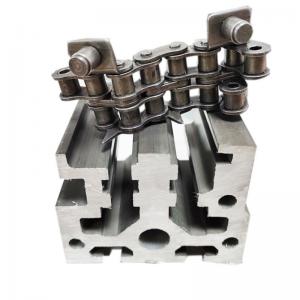Product Description:
An aluminium beam is a structural component made of aluminium alloy
and is commonly used in various engineering and manufacturing
applications. It is an elongated member with large cross-sectional
dimensions and relatively long length. Aluminium alloy beams are
commonly used in structural parts that bear and transmit loads,
such as automobile bodies, aircraft wings, and support structures
for buildings.
Manufacturing of aluminium alloy beams usually involves processes
such as selection, cutting, forming, machining and joining of
aluminium alloy materials. Aluminium alloy beams have the
advantages of light weight, high strength, corrosion resistance and
good malleability, making them an important component in many
industries. They can be tailored to meet different needs by using
different aluminium alloy materials and design processes to provide
the required strength, stiffness and durability.
The design and application of aluminium alloy beams requires
comprehensive consideration of loads, stresses, vibration and
thermal expansion, as well as sound structural optimisation. In
addition, the choice of fabrication and joining techniques plays an
important role in the performance and reliability of aluminium
alloy beams.
In conclusion, aluminium alloy beams are a kind of long structural
components made of aluminium alloy with the characteristics of
light weight, high strength and corrosion resistance, which are
widely used in automobiles, aircrafts, construction and other
fields. They are an important part of modern engineering and help
to improve the performance and efficiency of products.
Features:
Lightweight: The lower density of aluminium alloys makes them
lighter compared to steel beams, effectively reducing the weight of
the overall structure. For applications such as automobiles and
aircraft that require improved fuel economy and load capacity,
aluminium alloy beams can provide better performance.
Corrosion resistance: Aluminium alloys have good corrosion
resistance and are less susceptible to oxidation and corrosion.
This gives aluminium alloy beams a longer service life in harsh
environments and makes them suitable for corrosion-prone scenarios
such as outdoor or marine environments.
High strength: despite its low density, aluminium alloy has high
strength. Through reasonable design and process control, aluminium
alloy beams can provide sufficient strength and stiffness to meet
structural requirements.
Heat dissipation performance: Aluminium alloy has good thermal
conductivity and can effectively dissipate heat. In high
temperature working environments such as automobiles and mechanical
equipment, aluminium alloy beams can help reduce the temperature
and improve the working efficiency and stability of the equipment.
Plasticity: Aluminium alloy is easy to process and form, and can be
manufactured into complex shapes of beams through various process
methods. This provides designers with greater freedom to optimise
the design according to actual needs.
Applications:
Aluminium alloy beams are most widely used in the following areas:
Automotive industry: Aluminium alloy beams are widely used by
automobile manufacturers to reduce vehicle weight, improve fuel
economy and driving performance. Aluminium alloy beams can be used
in body chassis structures, wheel suspension systems and body
frames.
Aerospace industry: Weight requirements in the aerospace industry
are particularly stringent, so aluminium alloy beams are widely
used in the structure of aircraft and spacecraft. They can be used
for wings, fuselages, landing gear and other important components
to reduce the overall weight of the aircraft and improve fuel
efficiency and flight performance.
Construction: In the construction field, aluminium alloy beams are
commonly used to build lightweight building structures, such as
roof frames, overhanging structures and large-span buildings. Due
to their lightweight and corrosion-resistant properties, aluminium
alloy beams can reduce the dead weight of buildings and provide
good structural stability.
Transportation: In addition to cars and planes, aluminium beams can
also be used in other types of transportation such as trains, ships
and bicycles. In these applications, aluminium alloy beams can
provide advantages such as light weight, durability and fatigue
strength.
Sports equipment: Some sports equipment, such as bicycles, skis and
golf clubs, also use aluminium beams to provide strength and
rigidity. Aluminium beams can provide good performance for these
equipment and offer better control and stability during movement.
It is important to note that the applications of aluminium alloy
beams are not only limited to the above areas, but as technology
continues to advance and innovate, their use in other areas is also
expanding.


